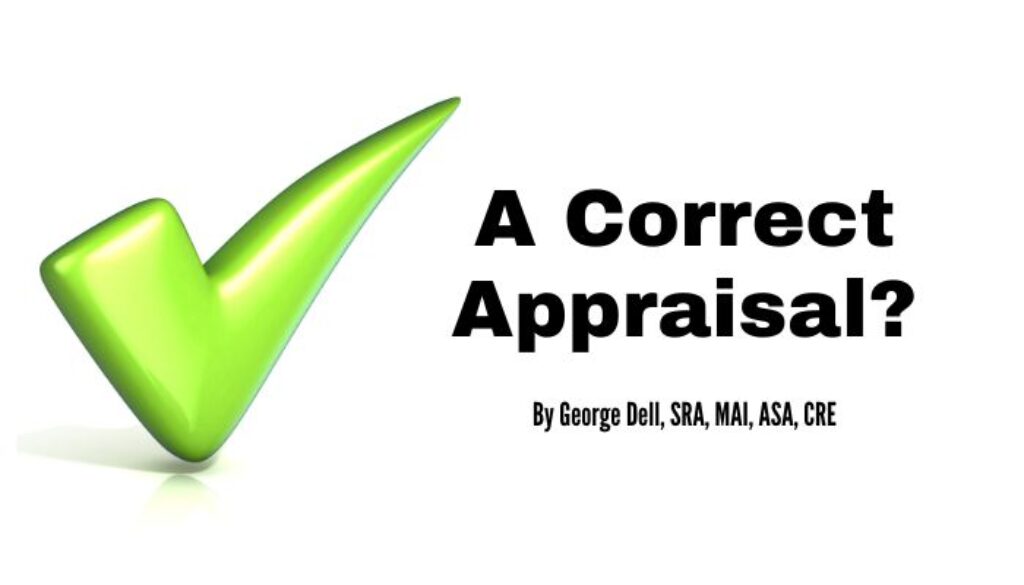Quasi-government “Congressionally-authorized” appraisal standards require “correct” research and analyses. What does that mean? What is correct? And who decides? It’s in Standard 1. Be correct.
Editor’s Note: This is Standards, part 3.14 of George Dell’s series on How Do I Move to EBV? Links to the earlier posts are here.
Does this say – it’s an administrative law “violation” of USPAP, if you are “incorrect”? Sounds serious.
In fact, the USPAP Section 1 Comment says this development standard can be used as a checklist! Let’s look. Let’s see how this checklist can distinguish a correct from an incorrect appraisal! All we ever asked for!
Standards Rule 1-1(a) first says an appraiser must “correctly employ those recognized methods and techniques.” (Emphasis added).
Then this same Standards Rule 1-1(a) Comment says the opposite – use new methods and techniques!
The “principle of change” recognizes that appraisal services must change. . . Specifically, it says appraisers “must keep abreast” of new methods and techniques.
There you have it. Stick to recognized methods, but change with the times. Check and check.
Standards Rule 1-1(b) says don’t make any big errors! OK! Got it! “Use sufficient care to avoid errors that would significantly affect his or her opinions and conclusions.” “Diligence is required.” Check.
Standards Rule 1-1(c) says don’t be so careless or negligent that it affects the believability of the results.
So, there you have our checklist:
- Use established methods: pick comps, make adjustments, and explain why your results don’t match up — three recognized, approved, and required “Approaches to Value.”
- Use new methods, given we have changes in real estate, construction, marketing, the legal framework, and social constructs.
- Make no big errors of commission or omission.
- Be not careless or negligent.
So, there is your USPAP recommended checklist. Follow it and be safe.
The USPAP document, published by the non-profit Appraisal Foundation, clearly states that it provides guidance on recognized valuation methods and techniques.
It is our hope that any future standards and organizations will allow and even encourage adoption of modern technology, data availability, and human interface.
EBV© Evidence Based Valuation education provides the essentials of “new methods and techniques.” EBV applies data science principles directly to property valuation and risk assessment.
EBV integrates existing appraiser competence and training with computer algorithms. The integration of brain-machine is a focus on market analysis via dynamic visualization and simple numerical tools.
We Measure Markets, not Compare Comps!
Visit Valuemetrics.info for paid and free education and training.

September 21, 2023 @ 7:47 am
How does EBV work with desk top appraisals or appraisals using third party for data collection
September 21, 2023 @ 8:34 am
I reviewed your comments regarding EBV, I agree to some degree, but that the reviewer is biased – not necessarily. As a reviewer many times it is not about the valuation segment as it is more the interpretation of the data before getting to the valuation section – the “common thread” that runs through the report is crucial. If the information and conclusions offered result in rational conclusions for those sections of the report prior to the valuation sections and those elements are applied in the valuation segments, then the value conclusions and opinions and value(s) are reasonable and defensible. The trouble is a valuation is an “opinion” not a fact. However, the appraisal industrial has been highjacked by the ABA, the Gov’t and more recently the Social mores of today resulting in USPAP doctrine that is useless as you point out.
After 46 Years an MAI, I, gave it up recently – they have done nothing to support the profession and continue to be only an educational organization and a poor one at that. I have taken courses that I taught years-ago that have not changed. AI should have a legacy program for tenured designated members where we are subject to such courses as USPAP and Ethics (which is useless and another discussion).
Also, the AI institution has never attempted to fight for the appraiser and push back since leaving NAR years ago.- no clout. Thus, today the industry has been reduce to a commodity and the professional status of the appraiser is no better than a tradesman like a carpenter and plumber – who by the way probably is better of financially than an appraiser since there has been a race to bottom with fees for those working for the lending community – who, in my estimation, is the coming “black swan” and the appraiser, again, the fall-guy.
Good luck
September 21, 2023 @ 9:58 am
I just had a data scientist request revisions on a report a spent a lot of time on within 20 minutes of submitting it.
October 12, 2023 @ 9:49 pm
EBV works as well as any other method for desktop assignments, if not better. Most EBV identifies a probable range much better than a legacy approach. Most desktop assignments find a range of values acceptable. A Desktop appraisal can provide very credible conclusions where the subject is reasonably well identified without a site visit. If the subject condition and details are unclear, that is another matter.